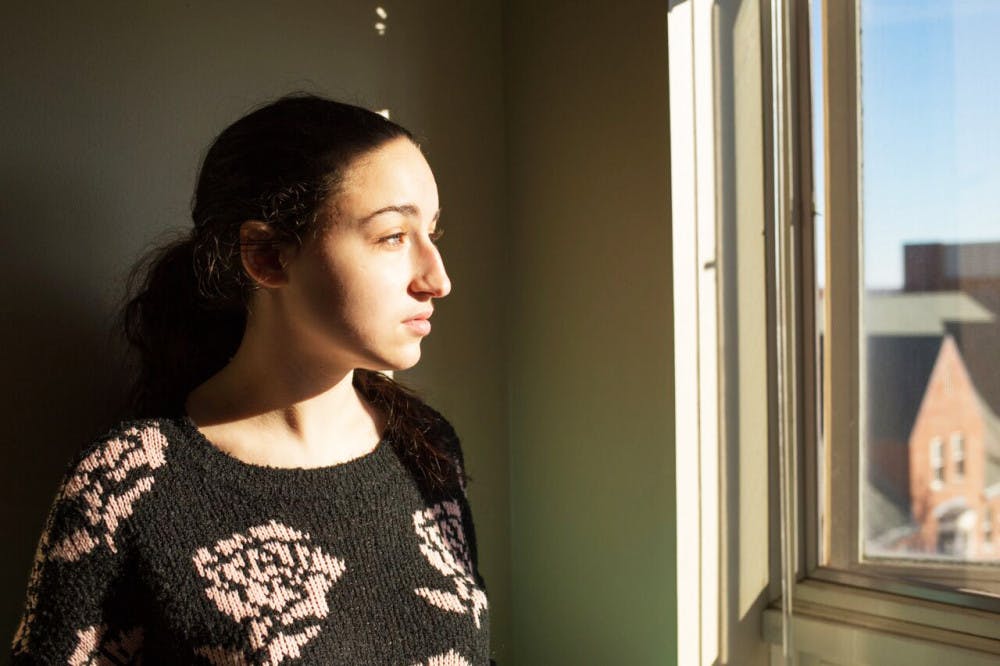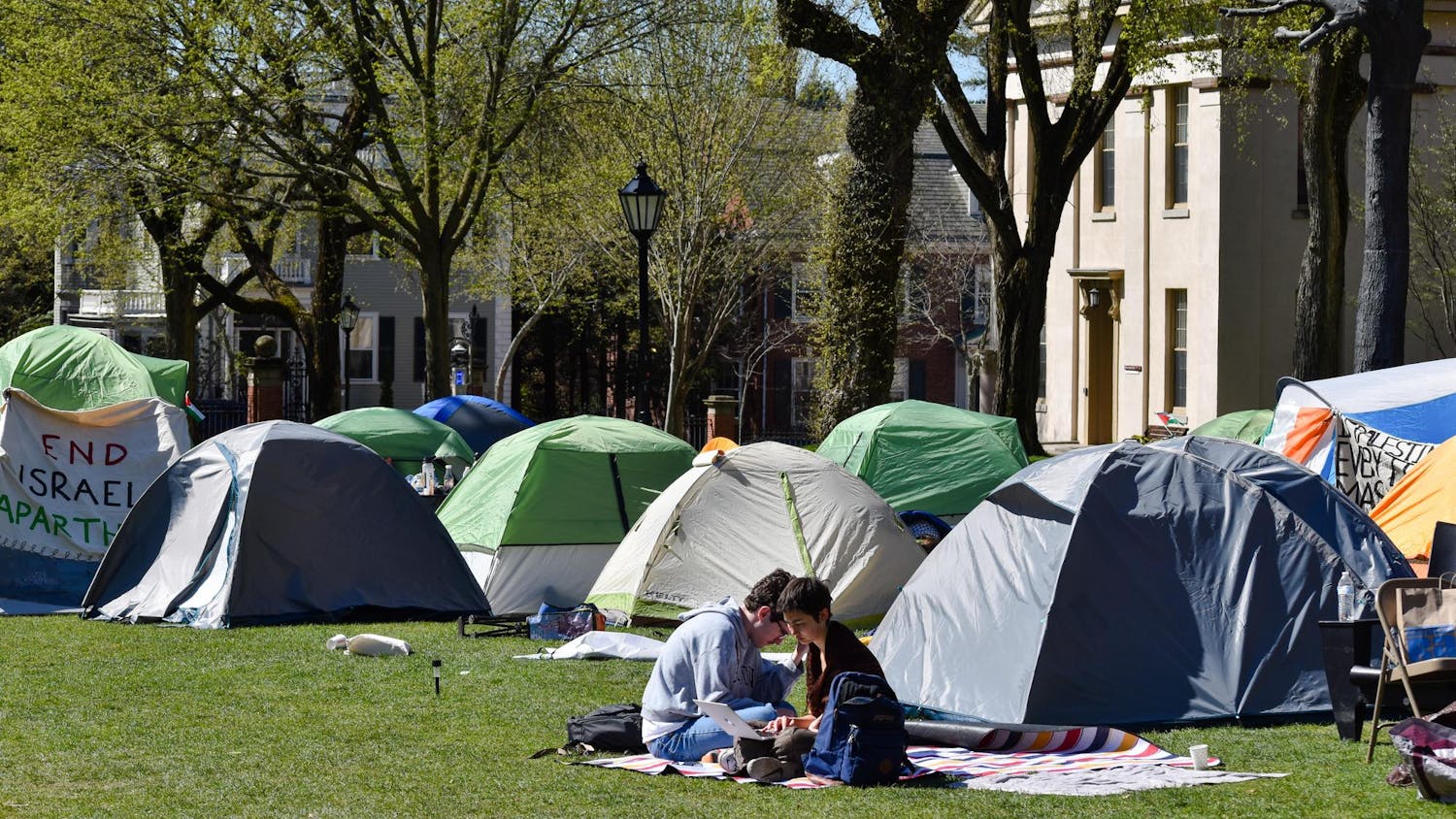This story is the first in a three-part series about mental health at Brown and students’ attempts to navigate the gaps in treatment and understanding.
Allie couldn’t breathe.
She had experienced panic attacks before but never like this. Though she had been battling depression since high school, the panic attacks were relatively new to her, beginning earlier this year.
She called Counseling and Psychological Services in early September for an appointment but was unable to schedule one until the middle of October.
But just a few days after her phone call to CAPS, Allie sat in Metcalf Auditorium in the midst of her worst panic attack yet. For a moment, she forced herself not to stand up — she did not want to make a scene within the crowded auditorium. But the pressure around her was too much. She began gasping for air.
“I got up and walked out of Metcalf, bawling,” she said. People turned in their seats, watching Allie leave in tears. “It was clear that people didn’t want to show that they were staring, but they were confused.”
“It got much worse before it got better,” Allie said. “I feel I could have avoided that if I had been able to talk to someone sooner.”
Allie, whose last name has been omitted to preserve her anonymity, is one of many students who has called CAPS in the middle of a mental health crisis and had treatment deferred due to CAPS’ long waitlist. As more students reach out for help, CAPS finds itself under-resourced and understaffed, making it difficult for students to receive timely help.
Turning to CAPS
At college campuses nationwide, more students than ever are facing mental health challenges, said Sara Abelson, vice president for student health and wellness at Active Minds, a national nonprofit working to eliminate the stigma surrounding mental health.
“Students are increasingly coming to campus with mental health concerns,” Abelson said. “Making sure that resources can grow as the population of students with concerns grows is a real challenge.”
CAPS, the University’s provider of mental health services, has 12 staff members, eight of whom are full-time therapists and counselors.
The office offers short-term therapy, group therapy and referrals to all enrolled students. All services are covered by the Health Services fee.
Last year, CAPS saw 18.9 percent of Brown’s student body, including graduate and medical students, said Sherri Nelson, director of CAPS. Utilization was highest for undergraduates, one in five of whom had visited, she said.
About 43 percent of seniors have visited at least once over the course of their time at Brown, according to a poll of undergraduates conducted by The Herald last month.
Campuses are not always equipped to serve the diversity of their student body, which may deter some students from seeking treatment, Abelson said.
“We know that many LGBT students are facing the most concerns but are not being seen at that same rate,” she said.
At Brown, 22.8 percent of heterosexual students have been to CAPS at least once compared to 46.4 percent of gay students and 45.7 percent of bisexual students, according to the poll.
Additionally, 8.9 percent of gay students and 5.7 percent of bisexual students had seen CAPS seven times and received outside help, whereas only 1.9 percent of heterosexual students had done the same.
Athletes may also face barriers to receiving care from on-campus counseling centers, Abelson said. Daytime practices on top of classes may leave athletes with no time to visit counselors, who typically work only during regular business hours. CAPS, for example, is open from 8:30 a.m. to 5 p.m.
Abelson said the competitive athletic environment can also create a “tough-it-up culture.”
“We want to make sure that coaches and staff are educated about the need for mental health and are able to communicate that it’s not problematic to seek help,” she said.
A disparity exists along lines of gender as well. Nationwide, women visit college counseling centers at higher rates than men do, Abelson said.
At Brown, 29.7 percent of women have gone to CAPS at least once, compared to only 21.9 percent of men, according to the poll. Of people who hit the seven-session limit and received off-campus help, 70 percent were women, and 26.7 percent were men.
“In society, help-seeking is portrayed more as a feminine thing,” said Marc Peters, men’s health coordinator. “From a young age, men are taught to tough things out, to not show emotion other than anger and to take things upon themselves because they aren’t supposed to be a burden.”
Men may fear judgment if they are seen going to CAPS, Peters added.
Though depression is more common in women than in men, the suicide rate for men is about four times higher than that for women, Peters said, adding that this disparity exists because men are less likely to seek help.
“Men will often self-medicate through use of substances. Since drinking is such accepted behavior in college, it can be easy to mask the fact that you’re struggling,” Peters said. He leads a men’s health group with CAPS psychotherapist Jamall Pollock to open up a dialogue about masculinity and wellness on campus.
Other demographic breakdowns exhibit similarly disparate patterns of CAPS attendance. First-generation students are also more likely to have used CAPS services. Of those students, about a third have used CAPS, compared to a quarter of all other students. Similarly, 7.2 percent of first-generation students had reached the seven-session limit and sought outside help, compared to 2.3 percent of other students.
Abelson said racial and ethnic minorities may also seek counselors at lower rates on some campuses.
The Herald's poll did not find statistically significant correlations between CAPS usage and race with one exception: While black students were about as likely as non-black students to have made a CAPS appointment, black students were more than twice as likely to have reached the seven-session limit and to have received outside help.
Nelson said the overall demographics of students seeking assistance from CAPS closely mirror those of the student body, with more than half the students CAPS sees identifying as students of color or international students.
Short-staffed and in demand
CAPS was created in 1970 with a three-person staff: its director and two part-time therapists, Nelson said. The office has been expanding ever since.
Called Psychological Services until April 2014, CAPS’ first home was the Health Services building. As the office grew, it moved into Rhode Island Hall on the Main Green where it remained for nearly 25 years. It was not until 2008 that CAPS moved into the fifth floor of J. Walter Wilson following the building’s extensive renovations.
Though the office was not placed under the umbrella of Health Services until this summer, it has always been completely funded by the Health Services fee, which students pay separately from tuition. With the exception of Cornell, which charges $10 per session, all Ivy League schools offer mental health counseling sessions for free.
Brown is also the only Ivy institution besides Dartmouth that imposes a limit on the number of counseling sessions students can receive. Yet Dartmouth’s limit of 12 sessions is nearly twice as high as Brown’s seven, which was raised from five in 2010.
A $500,000 dollar gift two years ago from an anonymous donor enabled CAPS to hire more clinical staff, increasing its clinical capacity by 50 percent, Nelson said. The University has now assumed responsibility for paying those salaries, she added.
But CAPS has struggled to hire enough staff members to keep up with growing demand from students. This semester the office was not fully staffed, and next semester it will temporarily lose two therapists who are taking maternity leave, Nelson said, adding that CAPS will hire “per diem therapists” to offset their absences.
There is currently one CAPS staff member for every 680 students. In an effort to increase that ratio, the office has taken steps in hiring, adding one postdoctoral position this semester and a licensed clinical social worker who will join the team in January.
“If we are down staff members, it doesn’t take much for us to get really busy,” Nelson said.
The shortage makes it near impossible to strike the seven-session limit in the near-term future, she added. This summer, the Mental Health Community Council recommended the limit be eliminated to account for emergency situations, though CAPS would still operate on a short-term therapy model.
Nelson said the University is committed to eliminating the limit by Fall 2017. The University has already allocated additional resources to CAPS to hire a body of staff that can take on the increased demand that would follow the striking of the limit.
Until CAPS can balance its responsibility to give all students access to its services with the need to keep a short waitlist, the office must continue to enforce a limit, Nelson said.
For now, the waitlist does not appear to be getting any shorter.
In crisis mode
The first time Allie called CAPS, she was given an appointment three weeks from the day she called. And after her panic attack in Metcalf, her situation worsened: She was having panic attacks every day.
“I didn’t know what to do,” Allie said. So she again called CAPS, which moved her appointment to within a week of that second call.
“When a student calls for an initial appointment at CAPS, they are always asked if there is an urgency to their call,” Nelson said. “That can vary from ‘I need to talk today’ to ‘I need to talk within a couple of days.’”
CAPS keeps crisis slots open for same-day appointments. In determining whether a student needs a same-day appointment, CAPS evaluates the risk of harm to the student or others, and looks to see if there are any acute difficulties in functioning, like an inability to get out of bed or persistent insomnia.
“We certainly give priority to safety,” Nelson said. “But we also understand that other issues rise to the level of crises for students, given the nature of the university setting and short semesters,” she wrote in a follow-up email to The Herald.
CAPS also focuses on intervening early in certain mental health episodes, such as disordered thinking, psychosis or severe depression.
Abelson, though, says that universities should seek to assist all students who express mental health concerns as early as possible.
“Universities are reaching students at a critical time in development. The college years are when the majority of mental health disorders are emerging for the first time,” she said. “The data consistently demonstrates that the earlier you seek treatment, the better the outcomes will be in the long term.”
Despite the value of early intervention, 18-24 year olds are the age group shown to seek help the least, according to a 2005 study by Harvard Medical School’s Ronald Kessler.
But when students are able to go to CAPS, many receive the therapy they need and are happy with their experience.
Mike Darby ’18 sought help from CAPS to treat his depression.
“The therapist was extremely helpful,” Darby said. “The problem is, the system that surrounds her isn’t the best.”
After seven sessions, he ran up against the limit and was forced to consider off-campus solutions.
Rachel, a sophomore whose name has been changed to preserve her anonymity, also said she had positive experiences at CAPS but was asked to seek off-campus support after three sessions.
During her last session with CAPS, Rachel was handed a list of therapists in Providence and their phone numbers. She was angry.
“How can (CAPS) expect an 18-year-old who might be in crisis — though I was not — to cold call therapists, set up appointments and figure out insurance?”
This summer, the University hired Jorge Vargas as its first student care coordinator to address that very problem. He works with students to ensure they have secured an off-campus therapist with whom they can continue treatment.
“We found that students weren’t always successful,” Nelson said. “Given that we have a brief therapy model, that means that we must refer students to the outside community. We wanted that referral to be more effective.”
As early as a student’s first session at CAPS, a therapist may give a referral to a few specific community providers, matching each student’s needs with outside therapists’ areas of expertise, Nelson said. Vargas and the student then decide on a timeline for discussing that student’s progress, either checking up with a phone call or a meeting “depending on how much help the student needs,” Nelson added.
Vargas has also been expanding the community provider database to increase the number and diversity of providers and document their areas of expertise and the insurance policies they accept, Nelson said.
Shifting the conversation
Of the students who come to Brown, 25 percent have previously sought mental health treatment, Nelson said. Among students who go to CAPS, that figure is even higher, at 40 percent.
Yet several students said they feel a stigma surrounding mental health at Brown.
“Occasionally, it can feel like I’m a complete and utter failure for not feeling happy at Brown, which is supposed to be the happiest place,” Darby said.
“Coming to Brown, a lot of mental health issues can manifest,” said Eliza Lanzillo ’16, president of Brown’s chapter of Active Minds. “People go from being one of the best in their high schools to feeling like they don’t measure up.”
About 57 percent of students expressed feeling inadequate to their peers in some way, according to a March 2015 Herald poll.
“Everyone is trying to make it look like they have it together,” said Amanda Ruggieri ’16, the chapter’s vice president. “It’s easy to feel like you’re the only one that’s experiencing that.”
Supporting mental health goes hand in hand with fostering dialogue about it on campus, Lanzillo said.
“When students report a positive environment for mental health on their campus, they are more likely to seek services,” Abelson said.
CAPS has been working with several student groups on campus, including Active Minds and Students for Samaritans, whose members volunteer for the Rhode Island Crisis Hotline. CAPS provided much of the financial backing for Active Mind’s Suicide Prevention Month display, Lanzillo said.
In an effort to provide more outreach programs, CAPS trained 30 staff members and students in the Question, Persuade, Refer suicide prevention program this fall, Nelson said.
With the increased visibility of mental health on campus, more students are advocating policy change. Expanding mental health services emerged as the second-highest priority for undergraduates on the Undergraduate Council of Students’ poll earlier this semester, with nearly 40 percent of students selecting that as their top priority, trailing only increases to financial aid.
This semester, students prioritized improving mental health services over sexual assault policy reform, said UCS President Sazzy Gourley ’16.
As students have started to see the implementation of the Sexual Assault Task Force’s recommendations, they have turned their attention to the proposals of the Mental Health Community Council, he said. CAPS “has a few new hires and the leave of absence dates have been changed, but broadly speaking, students have yet to feel those changes to mental health at Brown.”
UCS hopes to improve “the coordination of peer resources” by looking at the ways student Emergency Medical Technicians, Meiklejohns and Residential Peer Leaders support other students in their mental health needs, he said.
UCS has several short-term plans to improve awareness of CAPS services. For example, Gourley said the council is working to provide CAPS information on the back of student identification cards and will publicize Vargas’ new role, which Gourley said many students do not yet know about.
Students should also be informed early in their Brown careers about the availability of mental health services, Gourley said. While orientation includes mandatory meetings about sexual assault, diversity and alcohol, UCS supports the creation of a session about mental health.
UCS will push the University to be transparent about the implementation timeline for the MHCC’s August recommendations.
“It’s November,” Gourley said. “It’s time to see a more direct administrative response.”
Correction: Due to a data processing error, a previous version of this article misstated that The Herald's October 2015 poll did not find a statistically significant correlation between CAPS usage and race. In fact, it was statistically significant that black students were more than twice as likely to have reached the seven-session limit and to have received outside help. The Herald regrets the error.





